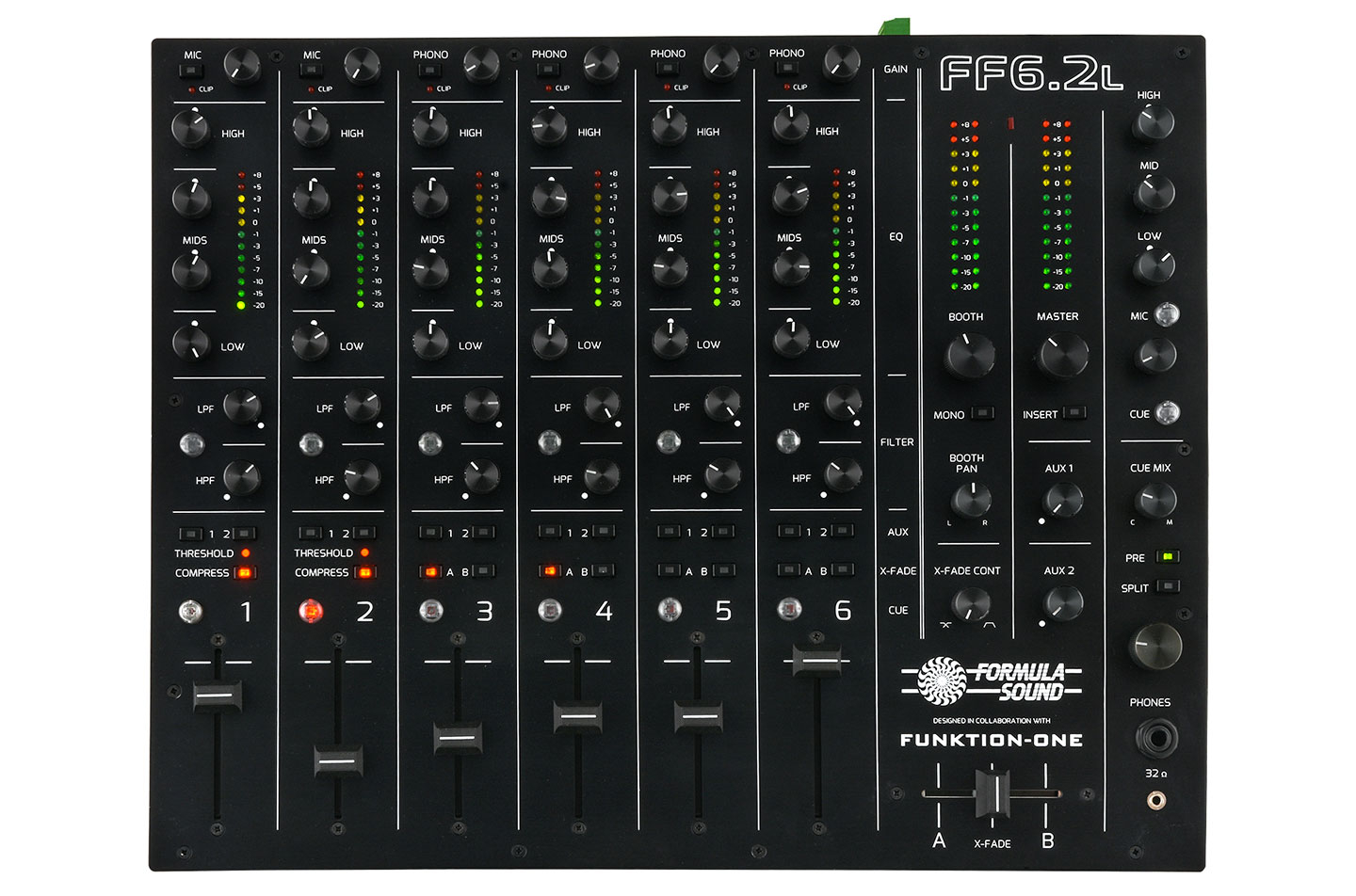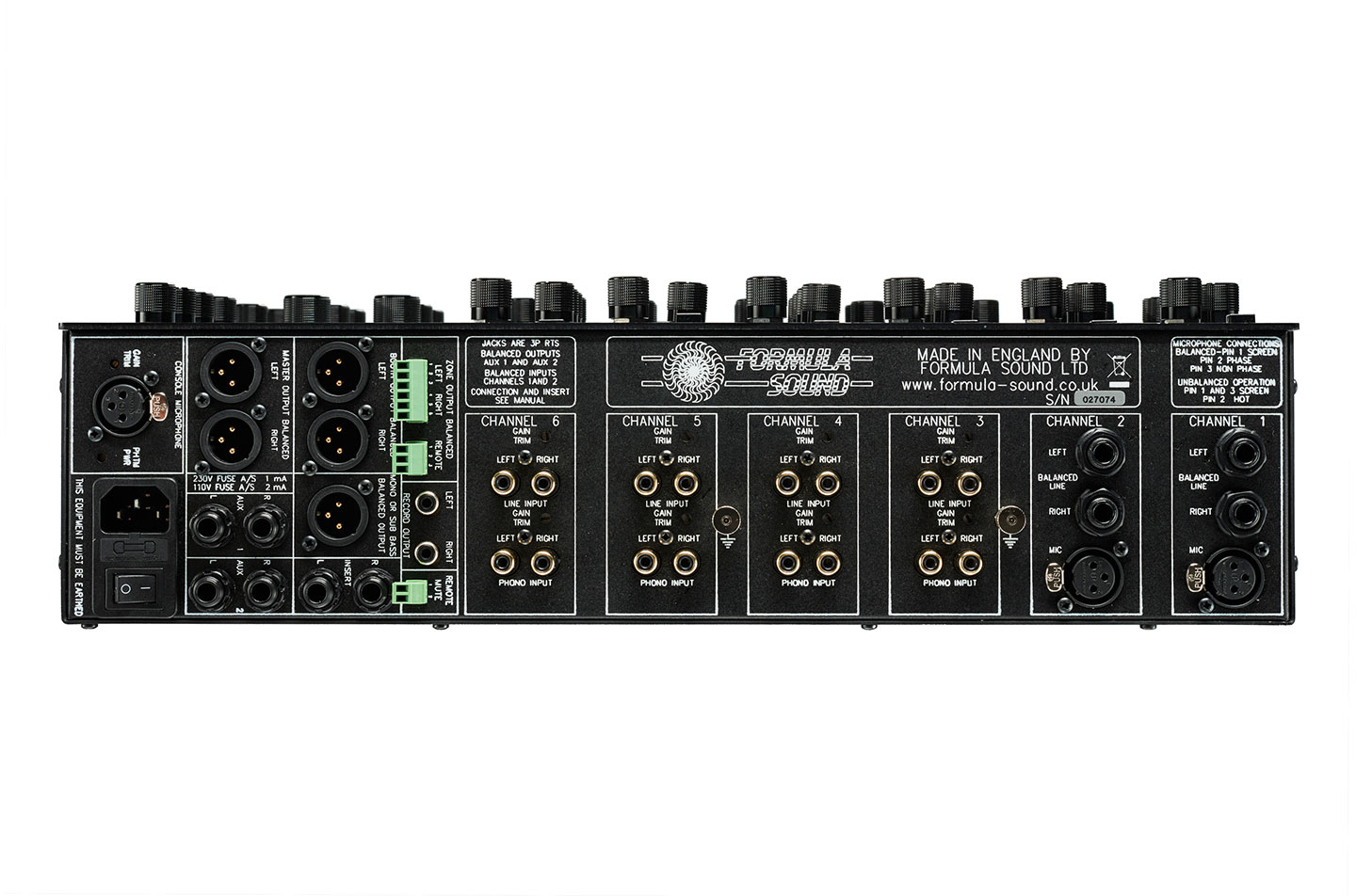- Over the last ten years or so, it's become increasingly common to see top-notch soundsystems installed in clubs and at dance music events. While many of these loudspeakers and amps have been built to specifications that spare no expense in pursuit of the best possible sound quality, DJ mixers are often consumer-oriented in comparison and so constitute a weakness in the signal chain. Of course, your perspective on this will be informed by how severely you've been bitten by the audiophile bug. The world continues to turn despite the prevalence of mixers with average sound quality and they're still the choice of many professional DJs. However, testing out a mixer like the Formula Sound/Funktion-One FF6.2 L makes it clear how much better nights out can sound when the mixer is on par with the rest of the system.
When mixers in the price bracket of the FF6.2 L are announced, the commenting public generally expresses disdain for the prohibitive price, which can top 4000 Euro (Funktion-One told me that you should ask your local dealer for a quote). The truth is, buying an FF6.2 L for personal use is at best an extreme luxury and at worst, total overkill. It is for clubs, for hiring companies, for touring DJs to put on their rider. It costs so much because Funktion-One wanted it to match the quality of their other products and Formula Sound built it in England using axial components and a linear power supply—they say the final cost was not considered during the development process. Companies building popular mixers are more in-tune with commercial product cycles, regularly releasing new versions with incrementally better specs. The FF6.2 L isn't supposed to be a hit product. Rather, it's meant to stand the test of time. Comparing it to a Xone or a DJM doesn't really make sense. However, it should be noted that there are plans for a rotary and four-channel version of the FF6.2, which should somewhat broaden the range's appeal and marginally increase accessibility.
The FF6.2 L dwarfs most mixers. It is wide, deep and emits a steady whirr from its internal fan. The size allows the controls to be generously spaced and the metal knobs are decidedly meaty. Two of the six channels feature switchable mic/stereo line inputs and include compressors for taming peaks, be they from an eager MC, an unruly external effects loop, a synth or a drum machine. Two auxes facilitate the external signal routing, which is then fed back into one of the six channels where it's subject to EQ, levelling, compression and so on.
One obvious and immediate benefit I noticed upon switching on the FF6.2 L was the similarity in the levels coming in from vinyl and digital sources. All too often in clubs, you're stuck maxing out the phono inputs in an attempt to match the levels of your digital files, which often come in too hot even when hitting similar levels on the meters while cueing. This is thanks to its quality preamps and ample headroom, and results in a sound best described as open. I never had the sensation of tracks fighting for space with two or even three faders up—or rather, I never noticed the extent to which this was happening in the past with other mixers. Even on smaller speakers, it feels like there's so much gain to spare that you could fit all manner of sonic material into the mix without elements vying for space. Pushing it into the red—as Ricardo has below—results in warm saturation rather than harsh clipping, though this isn't something one would recommend.
Part of the open feel lies in the faders. On some mixers, you get the feeling that the lower 30% of the fader essentially does nothing, with the signal only really becoming audible in the upper levels. On the FF6.2 L, I found that a track became audile far lower on the fader than I was used to. It feels like you're given greater control of nuances in level, which really helps with easing a track in subtly. I found that being able to have a second track accurately come in on this low level helped to establish a subtle change in tonal balance, setting the stage for a even blend. What I'm describing is certainly possible on other setups—the FF6.2 L just seemed to offer an unusual degree of detail. The correlation between what you're doing with your hands and what your ears hear is very strong.
The EQs sound closer to a channel strip on a console than a DJ mixer. The four-bands are full-kill but are sloped and tuned in such a way that the signal manages to retain body despite drastic cuts. As with the faders, there's a subtle pleasure to teasing in the bands because you can follow the fine gradations in frequency response, giving one a heightened sense of control.
Each band feels well-placed for dance music. The low-mid controls the thwack of a kick, making it a great frequency to fill for an emphatic sense of impact at the height of a blend. The low is largely sub and it can be completely removed without making the track feel thin. The high-mid controls the hard edge of claps, snare and hats while the high band covers the sizzle at the very top of the spectrum. I also found aggressive settings remained musical where other mixers would turn shrill or sound overloaded.
The filters take a minute to get used to. There's a low- and high-pass on every channel. They're enabled with a single switch, which means you need to take care of the position of both filters—more than once, I accidentally band-passed a signal that only needed a high-pass—but you quickly become accustomed to the workflow. Another difference to other filters is a lack of resonance control. The decision was informed by the propensity for resonant filters to destroy soundsystems at the hands of reckless DJs. So these filters aren't mean to produce sizzling, dramatic sweeps. Yet another difference is their transparent nature. For instance, you can sweep the high-pass all the way to the highest position without the track turning into narrow, hissing band of high frequencies. Like an old rotary, you can easily perform all your blends using just the faders and the filters. This approach makes for a natural, full sound suitable to classic mixing styles. However, using filters together with the EQ, one can select and enunciate elements surgically. So if you want to pick a certain hat or clap out of a production before filtering in the rest of the track, you can.
The most important takeaway I had with the FF6.2 L is that the open sound, gain, EQ and filters combine in such a way as to make you listen more closely to what you're doing in each mix. With your headphones off you can just focus on what's coming out of the speakers and hear how your moves affect the balance of the blend. You end up following your ears intuitively rather than going through the motions, so to speak, which is invaluable. This made mixing between different production styles far smoother for me. In a nutshell, it made mixing more fun, but that's not surprising given that one rarely gets a chance to use a mixer of this calibre. You might not be taking one home any time soon, but if you're lucky enough to get a chance to use it at a club, you'll feel and hear that the FF6.2 L is a mixer of rare quality.
Ratings:
Cost: 3.0
Versatility: 4.3
Sound: 4.8
Ease of use: 4.0
 Part of the open feel lies in the faders. On some mixers, you get the feeling that the lower 30% of the fader essentially does nothing, with the signal only really becoming audible in the upper levels. On the FF6.2 L, I found that a track became audile far lower on the fader than I was used to. It feels like you're given greater control of nuances in level, which really helps with easing a track in subtly. I found that being able to have a second track accurately come in on this low level helped to establish a subtle change in tonal balance, setting the stage for a even blend. What I'm describing is certainly possible on other setups—the FF6.2 L just seemed to offer an unusual degree of detail. The correlation between what you're doing with your hands and what your ears hear is very strong. The EQs sound closer to a channel strip on a console than a DJ mixer. The four-bands are full-kill but are sloped and tuned in such a way that the signal manages to retain body despite drastic cuts. As with the faders, there's a subtle pleasure to teasing in the bands because you can follow the fine gradations in frequency response, giving one a heightened sense of control. Each band feels well-placed for dance music. The low-mid controls the thwack of a kick, making it a great frequency to fill for an emphatic sense of impact at the height of a blend. The low is largely sub and it can be completely removed without making the track feel thin. The high-mid controls the hard edge of claps, snare and hats while the high band covers the sizzle at the very top of the spectrum. I also found aggressive settings remained musical where other mixers would turn shrill or sound overloaded.
Part of the open feel lies in the faders. On some mixers, you get the feeling that the lower 30% of the fader essentially does nothing, with the signal only really becoming audible in the upper levels. On the FF6.2 L, I found that a track became audile far lower on the fader than I was used to. It feels like you're given greater control of nuances in level, which really helps with easing a track in subtly. I found that being able to have a second track accurately come in on this low level helped to establish a subtle change in tonal balance, setting the stage for a even blend. What I'm describing is certainly possible on other setups—the FF6.2 L just seemed to offer an unusual degree of detail. The correlation between what you're doing with your hands and what your ears hear is very strong. The EQs sound closer to a channel strip on a console than a DJ mixer. The four-bands are full-kill but are sloped and tuned in such a way that the signal manages to retain body despite drastic cuts. As with the faders, there's a subtle pleasure to teasing in the bands because you can follow the fine gradations in frequency response, giving one a heightened sense of control. Each band feels well-placed for dance music. The low-mid controls the thwack of a kick, making it a great frequency to fill for an emphatic sense of impact at the height of a blend. The low is largely sub and it can be completely removed without making the track feel thin. The high-mid controls the hard edge of claps, snare and hats while the high band covers the sizzle at the very top of the spectrum. I also found aggressive settings remained musical where other mixers would turn shrill or sound overloaded. The filters take a minute to get used to. There's a low- and high-pass on every channel. They're enabled with a single switch, which means you need to take care of the position of both filters—more than once, I accidentally band-passed a signal that only needed a high-pass—but you quickly become accustomed to the workflow. Another difference to other filters is a lack of resonance control. The decision was informed by the propensity for resonant filters to destroy soundsystems at the hands of reckless DJs. So these filters aren't mean to produce sizzling, dramatic sweeps. Yet another difference is their transparent nature. For instance, you can sweep the high-pass all the way to the highest position without the track turning into narrow, hissing band of high frequencies. Like an old rotary, you can easily perform all your blends using just the faders and the filters. This approach makes for a natural, full sound suitable to classic mixing styles. However, using filters together with the EQ, one can select and enunciate elements surgically. So if you want to pick a certain hat or clap out of a production before filtering in the rest of the track, you can. The most important takeaway I had with the FF6.2 L is that the open sound, gain, EQ and filters combine in such a way as to make you listen more closely to what you're doing in each mix. With your headphones off you can just focus on what's coming out of the speakers and hear how your moves affect the balance of the blend. You end up following your ears intuitively rather than going through the motions, so to speak, which is invaluable. This made mixing between different production styles far smoother for me. In a nutshell, it made mixing more fun, but that's not surprising given that one rarely gets a chance to use a mixer of this calibre. You might not be taking one home any time soon, but if you're lucky enough to get a chance to use it at a club, you'll feel and hear that the FF6.2 L is a mixer of rare quality. Ratings: Cost: 3.0 Versatility: 4.3 Sound: 4.8 Ease of use: 4.0
The filters take a minute to get used to. There's a low- and high-pass on every channel. They're enabled with a single switch, which means you need to take care of the position of both filters—more than once, I accidentally band-passed a signal that only needed a high-pass—but you quickly become accustomed to the workflow. Another difference to other filters is a lack of resonance control. The decision was informed by the propensity for resonant filters to destroy soundsystems at the hands of reckless DJs. So these filters aren't mean to produce sizzling, dramatic sweeps. Yet another difference is their transparent nature. For instance, you can sweep the high-pass all the way to the highest position without the track turning into narrow, hissing band of high frequencies. Like an old rotary, you can easily perform all your blends using just the faders and the filters. This approach makes for a natural, full sound suitable to classic mixing styles. However, using filters together with the EQ, one can select and enunciate elements surgically. So if you want to pick a certain hat or clap out of a production before filtering in the rest of the track, you can. The most important takeaway I had with the FF6.2 L is that the open sound, gain, EQ and filters combine in such a way as to make you listen more closely to what you're doing in each mix. With your headphones off you can just focus on what's coming out of the speakers and hear how your moves affect the balance of the blend. You end up following your ears intuitively rather than going through the motions, so to speak, which is invaluable. This made mixing between different production styles far smoother for me. In a nutshell, it made mixing more fun, but that's not surprising given that one rarely gets a chance to use a mixer of this calibre. You might not be taking one home any time soon, but if you're lucky enough to get a chance to use it at a club, you'll feel and hear that the FF6.2 L is a mixer of rare quality. Ratings: Cost: 3.0 Versatility: 4.3 Sound: 4.8 Ease of use: 4.0